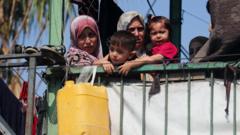Authorities are focused on providing immediate relief to thousands affected by the magnitude-7.1 earthquake that has left communities in dire need.
Tibet's Earthquake Survivors Battling Harsh Winter Conditions

Tibet's Earthquake Survivors Battling Harsh Winter Conditions
Rescue efforts intensify in Tibet following a devastating quake amidst freezing temperatures.
On Tuesday, a powerful magnitude-7.1 earthquake struck Tibet's Dingri County, close to Nepal, causing catastrophic damage and displacing tens of thousands. With reports confirming at least 126 fatalities and 188 injuries, the urgency of rescue operations is paramount as officials work under perilous conditions.
Rescue teams are tirelessly combing through the wreckage of over 3,000 damaged homes in subzero temperatures, enduring winds that further exacerbate the frigid atmosphere now settling over the area. Following the quake, which is marked as China's deadliest since December 2023, thousands of residents are being relocated to safer locations, while continuing medical attention is being administered to the injured.
The disaster has resulted in a staggering 660 aftershocks, complicating rescue operations. On the ground in Dingri County, temperatures plummeted to minus 18 degrees Celsius (0 Fahrenheit) at night, presenting immense challenges for rescue crews and survivors alike. Aerial photography has captured desolate scenes of frozen lakes, emphasizing the urgency of the situation as temperatures are predicted to remain low for at least three more days.
Tibet's remoteness complicates the situation. Rising security measures, stemming from historical tensions with Beijing, limit independent assessments, as foreign journalists face restrictions that inhibit their access to the area. Nevertheless, domestic media coverage has recorded significant efforts in providing relief, particularly concerning combating the intense cold.
Rescue efforts are increasingly centered on supply distribution to maintain warmth and shelter for those affected. Videos from the state broadcaster showcase teams erecting insulated tents, equipped with power generators to assist the displaced. Supplies of blankets and cots are being rapidly deployed to accommodate the urgent need for basic necessities.
Chinese Vice Premier Zhang Guoqing personally visited hospitals and support camps, urging teams to remain focused on locating additional survivors while ensuring those displaced are fed and protected from the winter chill. Remarkably, rescuers have managed to extract over 400 individuals from the debris within a single night, and approximately 30,000 others have been successfully relocated to safety.
Shortly after the quake, reports of road clearances and restoration of electricity emerged from surrounding towns, though numerous challenges continue to impact the region's recovery process. Despite the dire circumstances, the resilience of both rescuers and survivors shines through this tragic event.
Rescue teams are tirelessly combing through the wreckage of over 3,000 damaged homes in subzero temperatures, enduring winds that further exacerbate the frigid atmosphere now settling over the area. Following the quake, which is marked as China's deadliest since December 2023, thousands of residents are being relocated to safer locations, while continuing medical attention is being administered to the injured.
The disaster has resulted in a staggering 660 aftershocks, complicating rescue operations. On the ground in Dingri County, temperatures plummeted to minus 18 degrees Celsius (0 Fahrenheit) at night, presenting immense challenges for rescue crews and survivors alike. Aerial photography has captured desolate scenes of frozen lakes, emphasizing the urgency of the situation as temperatures are predicted to remain low for at least three more days.
Tibet's remoteness complicates the situation. Rising security measures, stemming from historical tensions with Beijing, limit independent assessments, as foreign journalists face restrictions that inhibit their access to the area. Nevertheless, domestic media coverage has recorded significant efforts in providing relief, particularly concerning combating the intense cold.
Rescue efforts are increasingly centered on supply distribution to maintain warmth and shelter for those affected. Videos from the state broadcaster showcase teams erecting insulated tents, equipped with power generators to assist the displaced. Supplies of blankets and cots are being rapidly deployed to accommodate the urgent need for basic necessities.
Chinese Vice Premier Zhang Guoqing personally visited hospitals and support camps, urging teams to remain focused on locating additional survivors while ensuring those displaced are fed and protected from the winter chill. Remarkably, rescuers have managed to extract over 400 individuals from the debris within a single night, and approximately 30,000 others have been successfully relocated to safety.
Shortly after the quake, reports of road clearances and restoration of electricity emerged from surrounding towns, though numerous challenges continue to impact the region's recovery process. Despite the dire circumstances, the resilience of both rescuers and survivors shines through this tragic event.




















